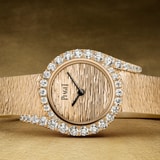
HOUSE OF GOLD
The glories and glamour of gold must have seemed a distant dream for watchmaker Georges-Édouard Piaget, when in 1874 he set up a workshop in the family farmhouse, in La Côte-aux-Fées, Switzerland.

By the 1950s the family-run company had become a Maison, garnering a global reputation for excellence and innovation that was sealed by their development, in 1957, of an ultra-thin movement, the 9P, a masterpiece of precision that changed the course of Swiss watchmaking history and the fortunes of Piaget.

In 1969, at the Basel Fair, Piaget unveiled the 21st Century collection, a series of strikingly contemporary, fabulously fashion-forward jewellery watches– the perfect marriage of Watchmaking and High Jewellery.
In tune with Piaget’s ethos, and its determination to aim ever higher and to break through conventions, the suitably futuristic 21st collection was unlike anything that had gone before : deep cuffs of graphic gold openwork, heavily textured gold bracelets, swinging twisted gold chain sautoirs vibrant coloured dials.
GOLD EMBEDDED IN THE HEART OF PIAGET
Gold was the shining hero of the collection. Piaget’s gold craftsmanship maximised this exuberance, drawing out life and warmth, tactility and sensuality, exploring the versatility of gold in order to turn timepieces into thrilling jewellery masterworks.

So much so that the dramatic watches in the 21st century collection were hailed in the press as the watches ‘of the international elite’.

Gold was, and is still today, central to the philosophy and spirit of the Maison. So vital is gold to Piaget’s vision and values, that the metal is melted in-house, in the Maison’s own foundry in Geneva.
DECOR PALACE
One of the most dramatic features of the 21st Century Collection was the heavily textured, rugged engraved gold of daringly wide watch bracelets. Decor Palace, a defining feature of Piaget’s goldwork was first developed in 1961, inspired by guilloché engraving.

This treatment broke with entrenched traditions of smooth, polished surfaces, of gold as a supporting act to gemstones, turning gold from a structural necessity into the main event, a thrillingly expressive, decorative feature in its own right. The rhythmic, fluid Decor Palace engraving requires a very particular skill.

This is a sign of the human touch that is so vital to Piaget. Through the years, the technique has been passed down through generations of goldsmiths, refined and evolved, so that this unique style of engraving can transform solid gold into tree bark, ice crystals, snakeskin scales, the glimmering surface of a Swiss lake, undulating ribbons of silk. Decor Palace, applied to watches and jewellery remains one of the most distinctive, and best-loved of Piaget signatures.
PIAGET, MAGICIAN OF GOLD
Piaget’s gold artistry and virtuoso craftsmanship have always worked together harmoniously to create an unmistakable Piaget signature, with crafts skills at the service of design.

Radiance becomes a recurring theme in Piaget artistry, seen to perfection in the use of marquise-cut diamonds, arranged around a Limelight Gala dial for example, like the rays of the sun.

The mesmerising molten beauty of gold has long fascinated artists. Salvador Dali was captivated by the association of gold with mysticism and alchemy, particularly by the allure of gold coins and medals. In the late 1960s, he minted his own series of coins, of different values and weights, sculpted with profile portraits of himself and his wife Gala. He called them Dali D’Or.
In the late 60s, Yves Piaget, who moved in artistic circles, wanted the world to understand that the dramatically new Piaget creations were contemporary works of art. He nurtured a connection with art and artists, starting with Dali. In 1967, Piaget collaborated with Dali on an exclusive collection of watches and jewellery incorporating the artist’s Dali d’Or coins.
PIAGET POLO 79 – A GOLDEN MILESTONE
Ten years after the unveiling of the 21st Century Collection, Piaget decided to demonstrate its mastery of gold with the Piaget Polo, the company’s first sports watch.

The Piaget Polo appealed to Piaget’s clientele of glitterati, many of whom, like Yves Piaget himself, played or watched polo, the sport of kings. With a case shaped between a circle and a square, the Piaget Polo captured the unisex zeitgeist of the 1970s, with models for both men and women.
Made entirely of solid 18 carat gold, the case and bracelet were totally integrated, more seamlessly than ever before, in a sleek, streamlined, yet fluid and voluptuous design. The overall effect was as if the watch was crafted from a single cast of gold.
Our Creations













